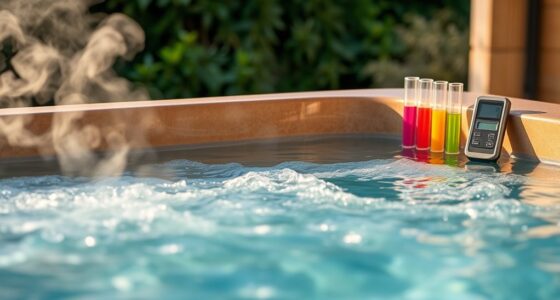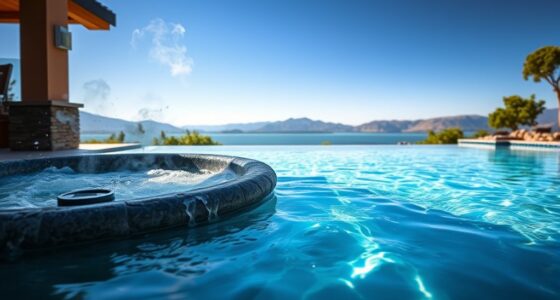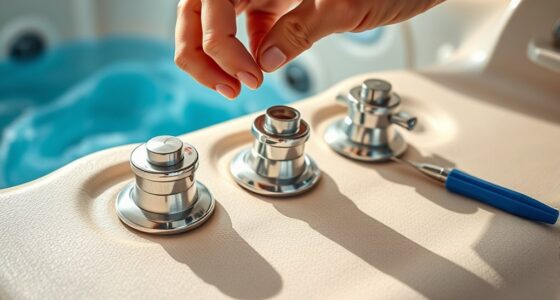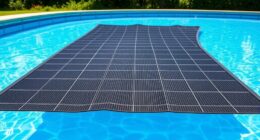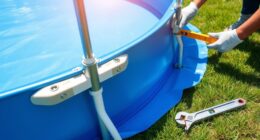Common hot tub water problems include cloudiness, foul odors, algae growth, and mineral scale, often caused by imbalanced chemicals, poor filtration, or organic contaminants. You might notice skin irritation, discoloration, or difficulty maintaining the proper pH. These issues can affect water clarity, safety, and your equipment’s longevity. Understanding the causes and solutions will help you keep your hot tub clean, clear, and comfortable—continue to explore ways to tackle these common challenges effectively.
Key Takeaways
- Cloudy or milky water caused by chemical imbalance, debris, or mineral deposits.
- Discolored water indicating contaminants, minerals, or algae growth due to poor sanitizer levels.
- Foam and bubbles from excess oils, lotions, or chemical imbalances.
- Hard water deposits and scale buildup affecting jets and heater efficiency.
- Persistent odors and algae growth resulting from unbalanced chemicals and organic contaminants.
Cloudy or Milky Water

Cloudy or milky water in your hot tub is a common issue that can be caused by several factors. One typical cause is an imbalance in your water chemistry, especially high pH or alkalinity levels, which can lead to calcium or mineral deposits that make the water appear cloudy. Another reason might be inadequate filtration or circulation, allowing dirt, oils, and debris to build up over time. Additionally, using too much or old sanitizer can contribute to cloudiness, as it leaves residues that cloud the water. Sometimes, organic contaminants like body oils, lotions, or sweat can also cause the water to look murky. Regular testing, balancing your chemicals, and proper filtration are essential steps to keep your hot tub water clear and inviting. Incorporating diverse filtration options can further improve water clarity by effectively removing particles and maintaining clean water, especially since filtration efficiency can be influenced by the contrast ratio and other technological features of your filtration system. Proper water chemistry management is vital to prevent recurring cloudiness and ensure a consistently clear and enjoyable hot tub experience. Additionally, choosing filters with advanced HEPA filtration can help trap smaller particles and improve overall water clarity. Ensuring consistent maintenance and cleaning of your filtration system is crucial for preventing recurring cloudiness.
Foul Odors in the Water
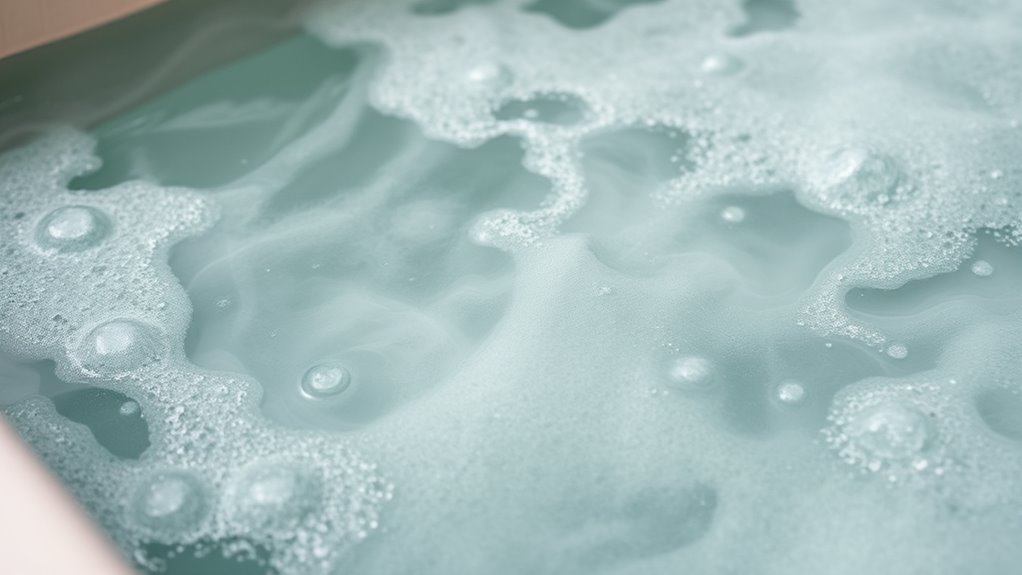
Foul odors in your hot tub water often indicate the presence of bacteria, algae, or organic contaminants that haven’t been properly treated. These odors can be sharp, sulfur-like, or rotten, signaling that your water isn’t clean enough for safe soaking. To address this, first test your water’s chemical balance and adjust the pH and sanitizer levels as needed. Shock the water with a high-dose sanitizer to kill bacteria and organic matter. Regularly clean your filter to remove debris that can harbor odors. Also, drain and refill your hot tub periodically to prevent buildup. Maintaining proper chemical balance and cleanliness will help eliminate foul smells, ensuring your hot tub remains fresh, safe, and inviting for every use. Incorporating water treatment like using appropriate cleaning products can also help keep your water clearer longer. Additionally, understanding Halloween traditions around the world can help you appreciate different cultural celebrations beyond your local practices. Proper chemical balance is essential for preventing odor issues and maintaining a healthy hot tub environment. Regular testing and water analysis can help detect issues before odors develop, keeping your hot tub odor-free.
Persistent Algae Growth

Persistent algae growth can be be a recurring issue if you don’t implement proper prevention techniques. Regularly brushing the sides and maintaining correct sanitizer levels help keep algae at bay. Effective cleaning strategies, like draining and scrubbing, are essential to stop algae from taking over your hot tub. Additionally, using appropriate water treatment systems similar to vetted hot tub maintenance products can further prevent algae buildup. Ensuring your water chemistry remains balanced is crucial, as improper water chemistry can promote algae growth and other water quality issues. Maintaining proper water chemistry balance is vital for overall hot tub health and preventing algae proliferation. Consistently monitoring and adjusting your water treatment protocols can significantly reduce the chances of algae reappearing. Implementing preventative measures such as regular shock treatments can also help inhibit algae development before it becomes a problem.
Algae Prevention Techniques
Have you noticed algae stubbornly growing in your hot tub despite regular cleaning? To prevent this, maintain proper sanitizer levels constantly. Use algaecide regularly, especially during warm months, to inhibit algae spores. Keep the water balanced; pH levels between 7.2 and 7.6 discourage algae growth. Cover your hot tub when not in use to block sunlight, which fuels algae. Also, run the jets periodically to circulate chemicals evenly. Here’s a quick guide:
| Tip | Why it helps | Best practice |
|---|---|---|
| Maintain sanitizer | Kills algae spores | Test weekly, dose as needed |
| Use algaecide | Prevents algae formation | Add monthly, especially summer |
| Keep water balanced | Discourages algae growth | Regular testing and adjustment |
Following these steps keeps algae at bay and your hot tub crystal clear.
Effective Cleaning Strategies
Even with preventive measures in place, algae can still cling stubbornly to your hot tub surfaces. To combat this, start by draining and thoroughly cleaning the tub with a non-abrasive cleaner designed for hot tubs. Use a soft brush to scrub away algae from walls, jets, and steps. Rinse well, then refill with fresh water. Once filled, shock the water with a high-quality sanitizing agent to kill remaining spores. Run the jets to circulate the sanitizer evenly. Regular brushing and shocking help prevent algae from re-establishing. Maintain proper water chemistry, especially pH and sanitizer levels. Consistent cleaning and monitoring are key to keeping your hot tub algae-free and inviting for relaxing dips.
Unbalanced Chemical Levels
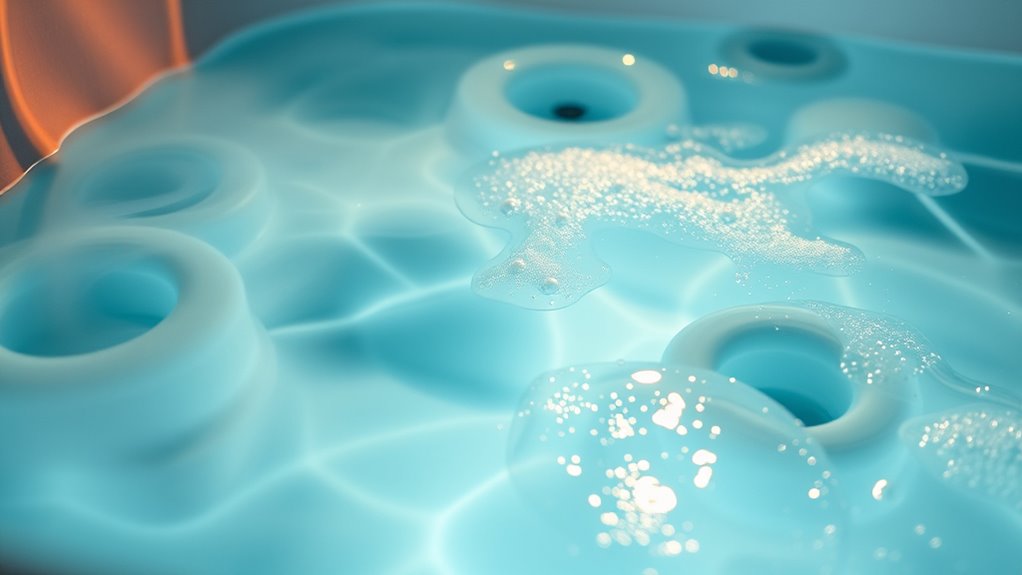
Unbalanced chemical levels can cause cloudy water, odors, and skin irritation in your hot tub. You might notice these issues if the sanitizer or pH levels are off. To fix this, you’ll need to identify the causes of imbalance and adjust the chemicals accordingly. Additionally, maintaining proper chemical balance is crucial for safe and trustworthy water quality. Regular testing with a reliable test kit can help you monitor and keep chemical levels within the recommended ranges. Using automatic chemical feeders can help maintain consistent chemical levels and reduce manual adjustments.
Causes of Imbalance
Chemical imbalances in hot tub water often occur because of improper testing or inconsistent chemical addition. When you don’t regularly check your water’s pH, alkalinity, or sanitizer levels, small fluctuations can quickly lead to imbalances. Adding chemicals haphazardly or without accurate measurement also causes issues, as too much or too little of a chemical disrupts the water’s balance. External factors like heavy use, debris, or environmental elements such as rain can further skew chemical levels. If you neglect routine testing and maintenance, these fluctuations will accumulate, resulting in cloudy water, odors, or algae growth. Maintaining consistent testing and precise chemical adjustments helps prevent imbalances by ensuring your hot tub’s water remains properly balanced and safe for use.
Signs of Chemical Issues
When your hot tub water starts to behave oddly—such as turning cloudy, developing a strong odor, or forming foam—it’s a clear sign that chemical levels are out of sync. These issues indicate your sanitizer, pH, or alkalinity might be off. Pay close attention to these symptoms:
| Symptom | Possible Cause |
|---|---|
| Cloudy water | Low sanitizer or pH imbalance |
| Strong odor | Excess organic matter or bacteria |
| Foaming | Surfactants or high sanitizer levels |
Recognizing these signs helps you identify chemical issues early. Regular testing and maintenance are key to keeping your hot tub water clean, clear, and safe for enjoyment.
Correcting Chemical Levels
If your hot tub water shows signs of imbalance, such as cloudiness, strong odors, or excessive foaming, it’s time to take action to correct the levels. First, test your water using a reliable test kit to determine the current pH, alkalinity, and sanitizer levels. Adjust the pH by adding pH increaser or decreaser as needed, aiming for a range of 7.2 to 7.6. Next, stabilize alkalinity by adding alkalinity increaser if it’s too low. Then, sanitize the water with the appropriate amount of chlorine or bromine, ensuring the sanitizer level stays within the recommended range. Regular testing and adjustments help maintain balanced chemical levels, preventing future problems and keeping your hot tub safe and comfortable.
Skin Irritation or Itching

Skin irritation or itching is a common problem caused by contaminated or improperly balanced hot tub water. When sanitizer levels are too low or uneven, bacteria and other microorganisms can thrive, leading to skin reactions. Additionally, high levels of certain chemicals, like chlorine or bromine, can cause dryness and irritation. Hard water with excess minerals may also contribute to itchy skin. To prevent this, regularly test and adjust your water’s pH, alkalinity, and sanitizer levels. Rinse off after soaking to remove residual chemicals. Ensuring proper water chemistry not only helps prevent skin issues but also extends the life of your hot tub components. Proper hot tub maintenance is essential for safe and comfortable use. Maintaining optimal water quality through consistent testing and adjustments can significantly reduce skin irritation. It’s also important to monitor for bacterial contamination that can occur if sanitation is neglected. If irritation persists, consider draining and thoroughly cleaning your hot tub, replacing the water, and ensuring the chemical balance is correct before use again. Proper maintenance helps keep your hot tub both safe and comfortable.
Foam and Bubbles Formation

Foam and bubbles in your hot tub often signal underlying issues that need attention. They can form from excess oils, lotions, or soap residues, or due to chemical imbalances in the water. Keeping your water properly maintained and balanced helps prevent foam buildup and keeps your hot tub clear. Additionally, understanding the antioxidant properties of certain honey varieties can inspire natural remedies for skin irritations that may occur from prolonged exposure to hot water. Regular testing and adjusting your water chemistry can prevent foam formation and maintain a safe, enjoyable hot tub experience.
Causes of Foam Buildup
Foam and bubbles often appear in hot tub water when surfactants, oils, lotions, and other organic contaminants are introduced into the water. These substances reduce water’s surface tension, making it easier for bubbles to form and persist. Shampoos, body oils, and cosmetics wash off your skin and settle in the water, creating foam buildup over time. Additionally, lotions and skincare products contain ingredients that are difficult to break down, further encouraging foam formation. Dirty filters or insufficient water circulation can also contribute by allowing contaminants to accumulate. When these organic materials are not regularly removed or filtered out, foam becomes more noticeable. To minimize foam buildup, you should regularly clean your hot tub and shower before use to reduce the introduction of these contaminants.
Chemical Imbalance Effects
A chemical imbalance in your hot tub water can considerably contribute to foam and bubble formation. When pH, alkalinity, or sanitizer levels are off, surfactants from lotions, oils, and contaminants can create persistent foam. These imbalances cause soap and organic residues to react, producing excess bubbles that are hard to eliminate. To understand this better, consider the following factors:
| Imbalance Type | Effect on Foam & Bubbles | Recommended Action |
|---|---|---|
| Low pH | Increases foam formation | Adjust pH levels upward |
| High pH | Causes cloudiness, bubbles | Lower pH to ideal range |
| High Alkalinity | Promotes foam buildup | Balance alkalinity |
| Excess Sanitizer | Creates foam, skin irritation | Reduce sanitizer levels |
| Organic Contaminants | Sustain foam | Regular water testing |
Keeping water balanced prevents foam and bubbles, ensuring a clearer, more comfortable soak.
Preventive Maintenance Tips
To prevent foam and bubbles from forming in your hot tub, regular maintenance is essential. Start by showering before use to reduce oils and lotions that contribute to foam. Keep your water balanced by testing and adjusting pH, alkalinity, and sanitizer levels weekly. Using a quality water clarifier can help prevent foam buildup, so add it as needed. Clean your filters regularly to ensure they remove debris that can cause foaming. Avoid adding excessive detergents or soaps to the water, and limit the use of oils or bubble bath products. If foam appears, run your filtration cycle longer and consider adding a foam reducer. Consistent maintenance keeps your hot tub water clear, balanced, and free of unsightly bubbles.
Hard Water Deposits and Scale

Hard water can cause significant problems in your hot tub by leaving behind mineral deposits that build up over time. These deposits, or scale, can clog jets, reduce heater efficiency, and make your water cloudy. The minerals—mainly calcium and magnesium—precipitate out of the water as it heats, forming deposits on surfaces. To understand the impact, consider this table:
| Mineral Type | Effect on Hot Tub | Prevention Tips |
|---|---|---|
| Calcium | Scale buildup | Use water softeners |
| Magnesium | Similar to calcium | Test water regularly |
| Other minerals | Clogs equipment | Maintain proper pH |
Keeping an eye on mineral levels and maintaining proper water chemistry helps prevent scale formation and prolongs your hot tub’s lifespan.
Water Discoloration

Water discoloration in your hot tub often signals the presence of contaminants, minerals, or chemical imbalances. If your water appears cloudy, green, or brown, it’s a sign something’s off. To address this, consider these key causes:
Discolored hot tub water indicates contaminants, minerals, or chemical issues needing attention.
- High mineral content – minerals like iron or manganese can stain water and surfaces.
- Algae growth – greenish tint indicates algae thriving due to poor sanitizer levels.
- Chemical imbalance – improper pH or sanitizer levels can lead to discoloration.
- Organic debris – leaves, oils, and lotions can introduce contaminants that discolor water.
Difficulty Maintaining Ph Balance

Maintaining the correct pH balance in your hot tub can be challenging because it’s easy for the levels to drift out of range due to frequent use, weather changes, or improper chemical additions. When pH gets too low, the water becomes acidic, which can cause skin irritation and damage to the hot tub’s equipment. If it’s too high, the water becomes cloudy and scaling can form on surfaces. To keep pH stable, regularly test your water with test strips or a kit, ideally once a week. Adjust the pH with pH increaser or decreaser as needed. Consistent testing and prompt adjustments help prevent fluctuations, making maintenance easier and ensuring your hot tub remains comfortable, safe, and in good condition.
Cloudiness Despite Filtration

Even when your filtration system is running smoothly, you might notice your hot tub water remains cloudy. This can be frustrating, but it often points to underlying issues. Here are four possible causes:
- Imbalanced Chemicals – Incorrect pH or sanitizer levels can lead to cloudiness.
- High Organic Load – Heavy use or organic debris can overwhelm filtration.
- Filter Maintenance – Dirty or clogged filters reduce efficiency, letting particles circulate.
- Poor Water Circulation – Insufficient flow prevents proper filtering and dispersal of chemicals.
To fix this, test and adjust your chemicals regularly, clean or replace filters, and ensure your jets are working correctly. Proper maintenance keeps your water clear and inviting.
Frequently Asked Questions
How Often Should I Change My Hot Tub Water?
You should change your hot tub water every 3 to 4 months to keep it clean and safe. Regularly testing and balancing the water’s pH and sanitizer levels helps extend the time between changes. If you notice cloudy water, strong odors, or skin irritation, it’s a sign to drain and refill sooner. Proper maintenance guarantees your hot tub remains inviting and hygienic for every soak.
Can Hard Water Damage My Hot Tub Equipment?
Did you know that hard water contains high levels of minerals like calcium and magnesium? These minerals can cause scaling, which damages your hot tub’s equipment over time. If you have hard water, it’s essential to use a water softener or regularly flush your hot tub. Ignoring this can lead to costly repairs, reducing your hot tub’s lifespan and performance. So, yes, hard water can definitely harm your hot tub equipment.
What Are Natural Remedies for Algae Control?
You want natural remedies to control algae in your hot tub. Start by regularly brushing the walls and floor to remove algae spores. Use natural treatments like adding baking soda or hydrogen peroxide, which help inhibit algae growth. Keep the water balanced in pH and sanitization levels, and guarantee proper filtration. These simple, natural steps help prevent algae without relying on harsh chemicals, keeping your hot tub clean and safe.
How Do I Prevent Chemical Imbalances Naturally?
To prevent chemical imbalances naturally, you should regularly monitor your hot tub’s pH and alkalinity levels using test strips or kits. Keep the water clean by filtering frequently and adding natural clarifiers like aloe vera or bentonite clay. Use natural disinfectants such as hydrogen peroxide or mineral sanitizers instead of harsh chemicals. Also, shower before use to reduce contaminants, and ensure proper circulation to maintain balanced, healthy water.
Is It Safe to Use Outdoor Hot Tubs in Winter?
Is it safe to use outdoor hot tubs in winter? Absolutely. Think of your hot tub as a cozy oasis amid the cold, where proper maintenance keeps water safe. You’ll want to monitor temperature, check for ice formation, and ensure the cover is secure to prevent heat loss. With these precautions, you can enjoy soothing warm water securely, even in the chilliest weather. Just stay vigilant and enjoy your winter soak!
Conclusion
To keep your hot tub inviting and safe, addressing water problems promptly is key. For example, Jane ignored cloudy water, only to discover algae had taken hold, leading to more costly repairs. Regular testing, balancing chemicals, and proper maintenance can prevent such issues. By staying proactive, you guarantee your hot tub remains a relaxing, clean oasis—free from odors, algae, and irritation. Don’t wait—your soothing soak depends on clear, healthy water.


